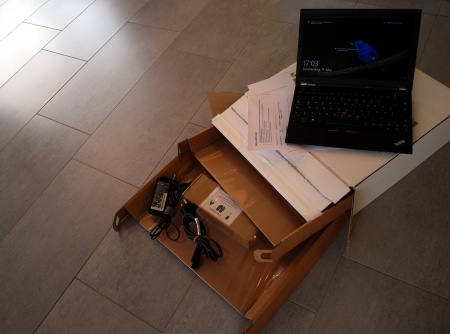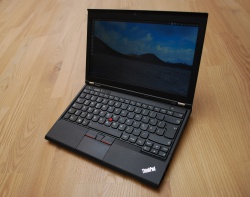Difference between revisions of "Ubuntu 16.04 LTS on Lenovo Thinkpad x230"
Marc Saric (talk | contribs) |
Marc Saric (talk | contribs) |
||
| (15 intermediate revisions by the same user not shown) | |||
| Line 1: | Line 1: | ||
| − | I recently bought a refurbished Lenovo Thinkpad x230, which came with Windows 10. | + | [[Image:x230.jpg|right|thumb|450px|[[help:contents|Lenovo x230 Notebook with packaging and new battery, running Windows 10.]]]] |
| + | I [https://www.greenpanda.de/ recently bought a refurbished Lenovo Thinkpad x230], which came with Windows 10. | ||
| + | <div style="clear: both;"></div> | ||
Of course I had to install Linux. | Of course I had to install Linux. | ||
| − | == Installation == | + | = Technical data = |
| + | |||
| + | List of technical details regarding my x230. There are different models out there, which differ in CPU, memory, display-specs and extra components (card-readers, fingerprint-readers, disk drivers, UMTS-radios, etc.). | ||
| + | |||
| + | {| width="90%" align="center" | ||
| + | |- valign="top" | ||
| + | | colspan="3" | '''Lenovo Thinkpad x230''' | ||
| + | |- valign="top" | ||
| + | | rowspan="11" |[[Image:x230_linux.jpg|left|thumb|250px|[[help:contents|Lenovo x230 Notebook]]]] | ||
| + | | '''CPU''' | ||
| + | | Intel Core i5-3320M (2.60 GHz, 3MB Cache) | ||
| + | |- valign="top" | ||
| + | | '''Chipset''' | ||
| + | | Intel QM77 Express | ||
| + | |- valign="top" | ||
| + | | '''BIOS''' | ||
| + | | -- | ||
| + | |- valign="top" | ||
| + | | '''Memory''' | ||
| + | | 8 GB RAM PC3-12800 1600MHz DDR3 | ||
| + | |- valign="top" | ||
| + | | '''Graphics''' | ||
| + | | Intel HD 4000 | ||
| + | |- valign="top" | ||
| + | | '''Display''' | ||
| + | | 1366x768, LED backlight | ||
| + | |- valign="top" | ||
| + | | '''Harddisk''' | ||
| + | | 256 GB SSD | ||
| + | |- valign="top" | ||
| + | |- valign="top" | ||
| + | | '''Connections''' | ||
| + | | | ||
| + | * 1x Audio-In/Out kombiniert | ||
| + | * miniDisplayport | ||
| + | * VGA | ||
| + | * 2x USB 3.0 | ||
| + | * 1x USB 2.0 powered | ||
| + | * Gigabit-Ethernet, Intel | ||
| + | |} | ||
| + | |||
| + | == Installation: Things which... == | ||
| + | |||
| + | === ...work out of the box === | ||
Downright boring. Installation of Ubuntu 16.04 LTS Desktop 64 bit from an USB-stick. Everything obvious (graphics, touchpad, display, WiFi) works right out of the box. | Downright boring. Installation of Ubuntu 16.04 LTS Desktop 64 bit from an USB-stick. Everything obvious (graphics, touchpad, display, WiFi) works right out of the box. | ||
| − | == | + | === ...work with tweaking === |
| − | |||
Despite ordering a new 48 Wh replacement battery from Sanyo, the laptop drains a full battery quite fast if running Ubuntu 16.04 (as most Linux distros do without power optimization). | Despite ordering a new 48 Wh replacement battery from Sanyo, the laptop drains a full battery quite fast if running Ubuntu 16.04 (as most Linux distros do without power optimization). | ||
| Line 32: | Line 76: | ||
See how this improves runtime. | See how this improves runtime. | ||
| − | More to | + | The network currently has issues when the laptop comes back from hibernation. This has not been the case at the beginning, so I suspect an issue with the current kernel as this seems to be kernel-module related (<pre>sudo systemctl restart network-manager.service</pre> does not solve it). See e.g. https://askubuntu.com/questions/761180/wifi-doesnt-work-after-suspend-after-16-04-upgrade or https://askubuntu.com/questions/452826/wireless-networking-not-working-after-resume-in-ubuntu-14-04. The solution for me was to reload the kernel modules in question with <pre>sudo rmmod iwldvm && sudo rmmod iwlwifi && sudo modprobe iwlwifi && sudo modprobe iwldvm</pre> |
| + | |||
| + | === ...don't work === | ||
| + | |||
| + | The Thinkpad special key -but who cares. | ||
| + | |||
| + | The aftermarket battery died on me after only 9 month of regular use. This is crap. However on the very positive side, the retailer immediately and without any fuss sent a replacement battery even without further proof, that the old battery was indeed broken. | ||
| + | |||
| + | This is hardly an issue with old Thinkpads, rather one with aftermarket batteries. I should probably have kept the original battery and bought a new original Lenovo battery indepenently instead. Who knows. We will see, how long the second aftermarket battery will last. | ||
| + | |||
| + | More recently, the Windows 10 partition died somehow. No detectable disk issues, so I would rule out hardware problems. This happened after the upgrade to Ubuntu 20.04 LTS, but I am not aware, that the NTFS driver did something to the Windows partition. | ||
| + | |||
| + | As it could not be restored using the on-board recovery, I wiped it and nowadays, there is no Windows on that machine any more. | ||
| + | |||
| + | == Recommendation == | ||
| + | |||
| + | Buy. New Ultrabooks are probably thinner and may have full-HD-screens but cost 3x the money of this system. The only real advantage may be a longer runtime with a small battery due to the low-power CPUs (which are not really faster than the > 3 year old CPU of this machine). However, you could buy a 9-cell battery pack + an extra second battery pack if you don't mind the extra kilogram of weight. | ||
| + | |||
| + | == Update == | ||
| + | |||
| + | The Laptop went through two OS-updates and a disk repartitioning, now running Ubuntu 20.04 LTS only. The original battery died after some time and was replaced by the vendor. I still think, that this is the best Laptop I ever had. | ||
Latest revision as of 15:49, 18 May 2020
I recently bought a refurbished Lenovo Thinkpad x230, which came with Windows 10.
Of course I had to install Linux.
Contents
Technical data
List of technical details regarding my x230. There are different models out there, which differ in CPU, memory, display-specs and extra components (card-readers, fingerprint-readers, disk drivers, UMTS-radios, etc.).
| Lenovo Thinkpad x230 | ||
| CPU | Intel Core i5-3320M (2.60 GHz, 3MB Cache) | |
| Chipset | Intel QM77 Express | |
| BIOS | -- | |
| Memory | 8 GB RAM PC3-12800 1600MHz DDR3 | |
| Graphics | Intel HD 4000 | |
| Display | 1366x768, LED backlight | |
| Harddisk | 256 GB SSD | |
| Connections |
| |
Installation: Things which...
...work out of the box
Downright boring. Installation of Ubuntu 16.04 LTS Desktop 64 bit from an USB-stick. Everything obvious (graphics, touchpad, display, WiFi) works right out of the box.
...work with tweaking
Despite ordering a new 48 Wh replacement battery from Sanyo, the laptop drains a full battery quite fast if running Ubuntu 16.04 (as most Linux distros do without power optimization).
Checking the battery with
upower -i /org/freedesktop/UPower/devices/battery_BAT0
reveals, that the battery is OK as advertised.
See http://thinkwiki.de/TLP_-_Linux_Stromsparen (in german, but it is only about TLP) for some hints specifically geared towards Thinkpads:
tl;dr:
sudo add-apt-repository ppa:linrunner/tlp sudo apt-get update sudo apt-get install tp-smapi-dkms acpi-call-dkms service tlp start
See how this improves runtime.
The network currently has issues when the laptop comes back from hibernation. This has not been the case at the beginning, so I suspect an issue with the current kernel as this seems to be kernel-module related (
sudo systemctl restart network-manager.service
does not solve it). See e.g. https://askubuntu.com/questions/761180/wifi-doesnt-work-after-suspend-after-16-04-upgrade or https://askubuntu.com/questions/452826/wireless-networking-not-working-after-resume-in-ubuntu-14-04. The solution for me was to reload the kernel modules in question with
sudo rmmod iwldvm && sudo rmmod iwlwifi && sudo modprobe iwlwifi && sudo modprobe iwldvm
...don't work
The Thinkpad special key -but who cares.
The aftermarket battery died on me after only 9 month of regular use. This is crap. However on the very positive side, the retailer immediately and without any fuss sent a replacement battery even without further proof, that the old battery was indeed broken.
This is hardly an issue with old Thinkpads, rather one with aftermarket batteries. I should probably have kept the original battery and bought a new original Lenovo battery indepenently instead. Who knows. We will see, how long the second aftermarket battery will last.
More recently, the Windows 10 partition died somehow. No detectable disk issues, so I would rule out hardware problems. This happened after the upgrade to Ubuntu 20.04 LTS, but I am not aware, that the NTFS driver did something to the Windows partition.
As it could not be restored using the on-board recovery, I wiped it and nowadays, there is no Windows on that machine any more.
Recommendation
Buy. New Ultrabooks are probably thinner and may have full-HD-screens but cost 3x the money of this system. The only real advantage may be a longer runtime with a small battery due to the low-power CPUs (which are not really faster than the > 3 year old CPU of this machine). However, you could buy a 9-cell battery pack + an extra second battery pack if you don't mind the extra kilogram of weight.
Update
The Laptop went through two OS-updates and a disk repartitioning, now running Ubuntu 20.04 LTS only. The original battery died after some time and was replaced by the vendor. I still think, that this is the best Laptop I ever had.

